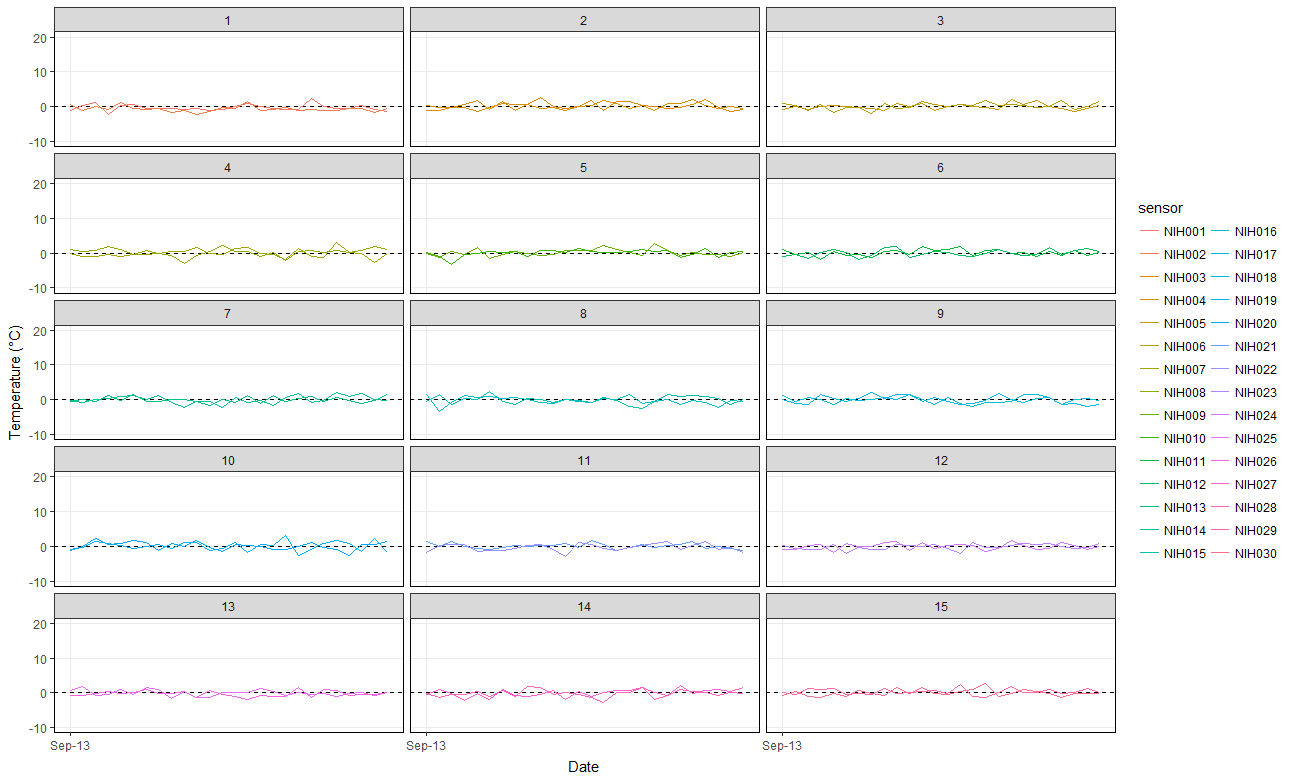You could do it like this if you actually want them to be each plotted totally separate:
library(tidyverse)
library(lubridate)
set.seed(1234)
# creating a dummy data frame that looks like your data
dat <- tibble(
date = seq.POSIXt(from = "2013-09-01" %>% as.POSIXct(.),
to = "2013-09-26" %>% as.POSIXct(.),
by = "1 day") %>% rep(., 30),
sensor = rep(1:30, each = 26),
# grid = rep(1:15, each = 52),
temp = rnorm(26*30)
) %>%
mutate(sensor = ifelse(sensor < 10,
paste0("NIH00", sensor),
paste0("NIH0", sensor))) %>%
spread(key = sensor, value = temp)
# transform data from wide to long
graphs <- dat %>%
gather(key = sensor, value = temp, NIH001:NIH030) %>%
# this may need to be changed based on how the sensors are grouped
# by grid. This assumes that sensor 1 and 2 are in grid 1
# sensor 3 and 4 are in grid 2 and so on
# and that each sensor has the same number of data points.
mutate(grid = rep(1:15, each = nrow(.)/15)) %>%
group_by(grid) %>%
nest() %>%
mutate(graphs = map(
data,
function(.x) {
ggplot(.x, aes(date, temp, color = sensor))+
geom_hline(yintercept = 0,color="black", linetype="dashed")+
geom_line() +
xlab("Date") +
ylab("Temperature (°C)")+
scale_x_datetime(date_breaks = "1 month",
date_labels = "%b-%y")+
scale_y_continuous(limits=c(-10,20))+
theme_bw()+
theme(plot.background = element_blank(),
panel.grid.major = element_line(),
panel.grid.minor = element_blank(),
panel.border = element_rect(size = 0.5, colour = "black"),
axis.line.x = element_line(size = 0.5, color = "black"),
axis.line.y = element_line(size = 0.5, color = "black"))+
# scale_colour_manual("",
# breaks = c("NIH001", "NIH002"),
# values = c("red", "blue"))+
theme(legend.position="top",
legend.direction="horizontal",
panel.background=element_rect(fill=NA,colour=NA),
legend.key = element_rect(colour = NA, fill = NA))
}
))
graphs$graphs %>%
map(print)
some notes:
- I changed your
scale_x_date to scale_x_datetime because the seq.POSIXt function I used to create the data creates datetime objects, so you may need to change it back to scale_x_date. Also, I changed the contents of this function to be less cumbersome for you.
- I had to change up your ggplot code since the data is not in long format and not wide format.
- You can change
print in the last map call to something like ggsave to save each of the images. Right now it will just print 15 separate graphs to the Plots pane.
On a separate note, it might be more desirable to do multiple facets rather than multiple plots. To do this you would do something like this:
# using the same data I created above
dat %>%
gather(key = sensor, value = temp, NIH001:NIH030) %>%
mutate(grid = rep(1:15, each = nrow(.)/15)) %>%
ggplot(aes(date, temp, color = sensor))+
facet_wrap(~grid, ncol = 3) +
geom_hline(yintercept = 0,color="black", linetype="dashed")+
geom_line() +
xlab("Date") +
ylab("Temperature (°C)")+
scale_x_datetime(date_breaks = "1 month",
date_labels = "%b-%y")+
scale_y_continuous(limits=c(-10,20))+
theme_bw()+
theme(plot.background = element_blank(),
panel.grid.major = element_line(),
panel.grid.minor = element_blank(),
panel.border = element_rect(size = 0.5, colour = "black"),
axis.line.x = element_line(size = 0.5, color = "black"),
axis.line.y = element_line(size = 0.5, color = "black"))+
theme(panel.background=element_rect(fill=NA,colour=NA),
legend.key = element_rect(colour = NA, fill = NA))
That would give you this:
Granted it is a little crowded but you could do a subset of the grids and do multiple plots either manually or in a similar fashion to what is done above

